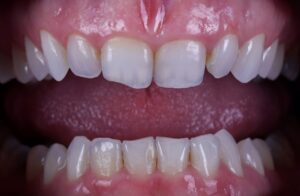Ceramic Porcelain Fracture Guidelines #3: Breaking Temporaries
by Dr. John Nosti
Temporaries, or provisional restorations, can be incredibly useful to anticipating the success or failure of restorative dentistry and effective treatment planning.
In my previous posts on ceramic porcelain fracture, I highlighted the notion that preventing fracture mainly comes down to the dentist’s ability to understand their patient. What goes on before or after the patient leaves the practice (teeth grinding, broken dentistry, etc.) can be just as crucial as the treatment they receive within it. Recognizing their tendencies and prior experience with dentistry is the best way to foolproof ceramic restorations.
Protect Patients Who Break Their Temporaries Repeatedly
Just as we determined in the second guideline that patients who experienced broken dentistry in the past will be more likely to experience fracture in new restorative dentistry, the same concept applies to broken temporaries.
In my first guideline, I laid out the process for correcting occlusion in patients who experience bruxism (teeth grinding). If your patient presents with fractured or missing temporaries after correcting the occlusion, this should immediately be a warning sign that the completed restoration will also result in fracturing.
Of course, there are situations where the temporaries themselves are the source of the problem, rather than an indication of a patient’s likelihood to present with fracture of a ceramic porcelain restoration. The ‘when’ and ‘how’ of fracturing must also be taken into consideration, as they may have simply bit down too hard on an object. If you notice that the patient reports consistent fracturing of temporaries during function, then the problem could stem from temporaries that violate the patient’s envelope of function.
At this point, it’s probably time to strongly recommend a protective appliance and warn the patient of the likelihood of the restoration requiring more time and energy to fix eventual fracture. A mandatory appliance should be suggested under two conditions:
- The patient wakes up from sleep with fractured temporaries.
- The patient experiences fracturing unconsciously during activities such as driving.
Subconscious parafunctional activity can be the root of the problem, but once it’s solved, the likelihood of fracture in the finished treatment decreases.
Look for the next three guidelines in this series to learn how to limit the percentage of porcelain fracture in your dental office. These tips are a compilation of ceramic restoration knowledge that I have put together over 10 years of performing “cosmetic rehabilitations.”
Read Dr. Nosti’s second guideline to ceramic porcelain fracture and his initial post on first steps to limiting fracture and dealing with misconceptions about what causes them.



